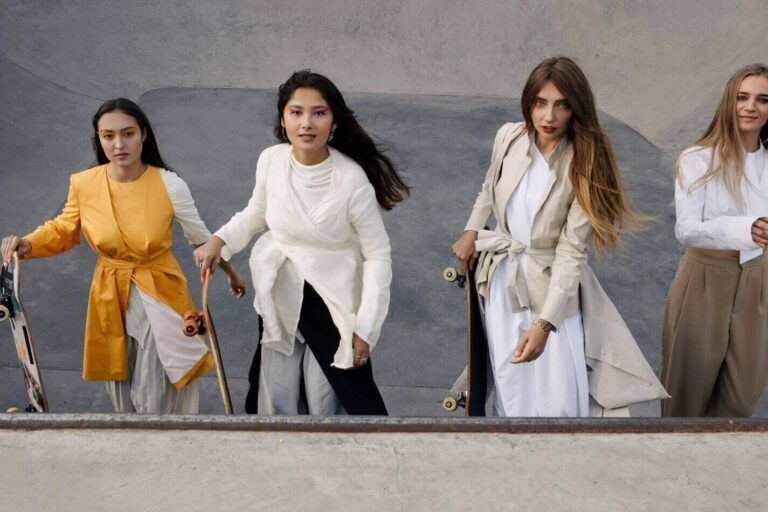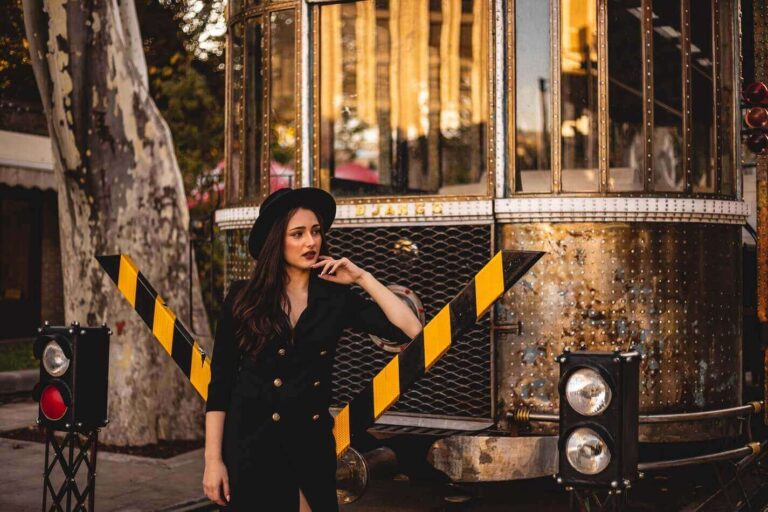the ethical fashion initiative | a consumers' fight for the rights of workers
feshene ea boitšoaro ke eng?
Fast Fashion not only created a production model where very cheap low-quality garments were made very fast following trends with no regard to the environment and the people, but it also gave more importance to fashion movements that wanted a sustainable fashion industry.
Ho tloha ka nako eo, metsamao ea feshene e kang Ethical, Sustainable and Slow Fashion e ile ea hlaha holimo in one way or another, e leng ntho e ntle haeba re iphapanyetsa litlamorao tse mpe tse Fast Fashion e nang le tsona lefatšeng la rona, producing 10% of the world’s greenhouse gas emissions and 20% of global wastewaters that pollute our rivers and seas.
Ethical Fashion e bua ka mokhatlo oa feshene o batlang liaparo tse entsoeng mabapi le basebetsi ba li etsang,barekisi le likhoebo tse nyane tse bapalang karolo molemong oa tlhahiso,khoebisano e nepahetseng, and the ethical treatment of all the agents related to the fashion industry, including the environment.
So in simple terms, it focuses on the ethical treatment of humans, and animals to achieve a sustainable fashion industry, with support for small businesses and the development of countries that are right now in unfavorable conditions.
how is ethical fashion different from sustainable fashion or slow fashion?
We have seen what Ethical Fashion is, but what do Sustainable Fashion and Slow Fashion mean? Aren’t they the same at the end of the day? Well, do not worry because we will be answering these questions now. Having said this, here are the differences between Ethical, Sustainable, and Slow Fashion:
- Sustainable Fashion is a movement that focuses on the sustainability of the garments it produces, making sure they are ecological and made from organic and biodegradable materials that have the minimal environmental impact possible. It basically wants to achieve a sustainable fashion industry by reducing the great environmental footprint it has. Read our Sustainable Fashion 101 to learn more about the subject.
- Slow Fashion is a movement that directly opposes Fast Fashion, from there it gets its name. It promotes garments made with slow manufacturing cycles with respect to the workers that produce them and the environment, strongly avoiding overproduction, disposal, and unnecessary consumerism which Fast Fashion promotes. It also encourages small businesses to promote competitiveness and innovation. If you want to know more about the subject feel free to read our Sefeshene se Bonya 101.
- Ethical fashion, on the other one, focuses on the rights of the workers and agents involved in the production process, in this way achieving sustainability in the fashion industry. It searches for garments made with ethical, decent wage labor with humane working conditions for all of its workers, while also promoting small businesses and vendors involved in the production process.
As you can see, they can differ a little bit, but all of these movements want to achieve the same thing, a sustainable fashion industry strongly opposing Fast Fashion and all the terrible consequences it has. Normally, businesses that sell ethical, slow, or sustainable fashion have garments that comply with all of these movements at the same time, so you shouldn’t feel in a position of choosing between one or another.
If you want to know more about Fast Fashion and its consequences don’t hesitate to check out our Fast Fashion 101 article.

the ethical fashion initiative | EFI
Ethical Fashion is actually the oldest of these movements that want to achieve a sustainable fashion industry, and it is not a surprise, as Sustainable Fashion and Slow Fashion were born as opposing forces to the Fast Fashion industry introduced by Zara in the 90s when environmental issues were beginning to be taken very seriously.
Ethical Fashion instead was born with the beginning of mass production and the bad situation of the workers of a still unproductive industry that was beginning to fully form. This happened roughly in the 50s and it has evolved greatly since then, but it has also gotten worse with the rise of Fast Fashion and the production of low-quality, cheap, and low added value garments.
This movement has not remained isolated, however, and organisms like the UN have begun to take action with their UN Alliance for Sustainable Fashion and their Ethical Fashion Initiative (ETI) to begin changing the world and avoiding terrible permanent damages.
This program aims to guarantee the ethical production of garments in the countries where modern slavery is likely to take place, applying standards for humane treatment and compensation for work that will also assure the development of these nations, as well as gender equality and all the rights people should have but are often forgotten about. You can read more about their Ethical Fashion Initiative Program on their website.
how to support ethical fashion
We have seen a lot of things about this fashion movement, but how can you support Ethical fashion? What can you do to be more ethical and support a sustainable fashion industry that cares for the workers, the environment, and also you? Well, you are lucky because there are a lot of options you can do right now from the comfort of your home! Having said this, here is how to support Ethical Fashion:
- Shop from businesses that you know are respecting their workers and agents involved in the production of their garments, preferably small businesses because you will be also supporting small families that also have to eat, and sadly today most big businesses simply do not care about their actions on the world, because of the Diffusion of responsibility phenomenon.
- Do not simply avoid all clothes made from underdeveloped countries, the fact that they are made in a country with less favorable conditions does not mean that the garment has been made with inhumane labor, countries that are rich today like Singapore, Taiwan, or South Korea have been producing garments with cheap labor for years before they finally developed. The problem is that Fast Fashion with its cheap low added value garments exploit the workers and do not even contribute to a fair development of the producing countries, which is very bad. That is why you should look for the ways the clothes are produced, and not where they are produced, because even in developed countries there can be garments made with forced labor.
- Read the business’ morals and how they are dealing with the sustainability of their operations, if they don’t even talk about sustainable practices then do not have trust in them, it is better to find a good business that cares for the people and doesn’t treat them like buy-n-throw tools to make extra money.
Here are some of the key things you can do to become more ethical with your fashion choices and support a sustainable fashion industry that cares for the people and the environment. Now you just need to put this into good practice 🙂

kakaretso
We hope you have learned a lot from this article because we have too! Now is the time to put all of this information into good practice, by changing your fashion habits a little bit at a time to achieve a sustainable and ethical fashion industry that will save our planet and species from doom. As we always say, you don’t have to go all crazy on it, one good deed at a time makes a big difference in the future.
Re thabetse ho ruta batho lefatšeng ka bophara 🙂 Hape,na u ne u tseba hantle hore na Fast Fashion ke eng le liphello tsa eona tse mpe tikolohong, polanete, basebetsi, sechaba le moruo?Na u tseba hantle hore na mokhatlo oa Slow Fashion kapa Sustainable Fashion movement ke eng?U lokela ho sheba lihlooho tsena ka taba ena e lebetsoeng le e sa tsejoeng empa e potlakile ebile e le ea bohlokoa,tlanya mona ho bala "Na Feshene e ka Feta e Tšoarehile?", kapaFast Fashion 101 | Kamoo E Senyang Lefatše la Rōnahobane tsebo ke e ’ngoe ea matla a matla ka ho fetisisa ao u ka bang le ’ona, athe ho hloka tsebo ke bofokoli ba hao bo bobe ka ho fetisisa.
Hape re na le ntho e makatsang bakeng sa hau!Hobane re batla ho u fa tokelo ea ho re tseba hamolemo, re lokiselitse leqephe le inehetseng la Mabapi le Rona moo re tla u bolella hore na re bo-mang, sepheo sa rona ke sefe, seo re se etsang, ho shebisisa sehlopha sa rona, le tse ling tse ngata. lintho!Se ke oa fetoa ke monyetla ona letlanya mona ho e hlahloba.Hape, re u mema hore usheba ronaPinterest,moo re tla kenya litaba tsa letsatsi le letsatsi tse amanang le feshene, mekhabiso ea liaparo, le lintho tse ling tseo ka sebele u tla li rata!
Phatlalatsa molaetsa:
- Tobetsa ho arolelana ho Pinterest (E buloa ka fensetere e ncha)
- Tobetsa ho arolelana ho Twitter (E buloa ka fensetere e ncha)
- Tobetsa ho arolelana ho Facebook (E bula ka fensetere e ncha)
- Tobetsa ho arolelana ho WhatsApp (E buloa ka fensetere e ncha)
- Tobetsa ho arolelana Reddit (E bula ka fensetere e ncha)
- Tobetsa ho arolelana ho Telegraph (E buloa ka fensetere e ncha)
- Tobetsa ho arolelana ho LinkedIn (E buloa ka fensetere e ncha)
- M oli
